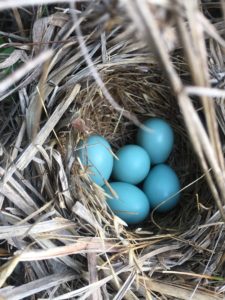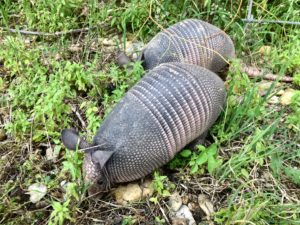It’s been a while since my last post as a result of COVID-19 risk mitigation protocols, but I have been able to continue working thanks to the isolated nature of many of my duties. In late April, I planted approximately 50 acres of native grasses and forbs in our Pastures for Upland Birds (PUB) project areas on the farm, using a no-till seed drill graciously loaned to us by the Texas Parks & Wildlife Department. While I was in the tractor planting at our Granger site, I took a fun little video (see the Facebook post) of a Swainson’s hawk (Buteo swainsoni) post-dive; it made what appeared to be a failed attempt to capture a prey item in the thatch, before lifting off when the tractor approached. Regarding the planting itself, I have been monitoring growth ever since, and so far, the results are looking promising. We won’t be able to determine an accurate measure of success for a couple of years while we wait for the natives to establish and hope for adequate rainfall, but I’ve included a few photos of the seedlings, taken about a week ago, which are the short grass and forb sprouts still in visible rows. The invasive johnsongrass (Sorghum halepense) that has grown up over the natives is not ideal, and we are looking into control measures, but there is also hope backed up by outcomes from other native restoration projects in the area that the johnsongrass will die back during the winters while the natives continue to establish, so over time, the johnsongrass will not have the resources to grow back.
The Partners project planning has been progressing well, with the budget for the trail construction approved. In the meantime, I’ve built a convertible picnic-table bench, dubbed the T’bench, that will be the first of six sets, intended to provide outdoor seating for future visitors to what will become a nature education site. The half-mile trail loop has been marked out, with extra care to avoid disturbing the dickcissel (Spiza americana) nest I found along the way (photo included), so now I am just waiting for the project area to finish drying out before I bring in the heavy equipment to begin excavating and laying the trail aggregate. I am looking forward to becoming proficient in the use of a skid steer and roller during this process.
I’ve had quite a few exciting wildlife encounters in my exploits here at the farm since my last post, so I have a selection of additional stories and photos to share. I was able to approach three juvenile armadillos who came out of our HQ haybarn to forage one afternoon. While armadillos are usually nocturnal, a storm front was coming in and I think the little guys got confused by the darkening sky and cooler temps and thought it was evening already and time for a meal! They hung around for about ten minutes, not bothered at all by my presence, before perhaps realizing it was still full daylight and meandering back into the barn for further napping. Nine-banded armadillos are born as identical quadruplets, meaning there are either four males or four females in a litter; hopefully, the fourth sibling of this little band of explorers was just smarter than its compatriots and stayed inside to finish sleeping the day away. During the same afternoon, I rescued a mockingbird fledgling out of well that was too deep for it to flip-flap out on its own. This one must’ve recently flown the coop, and went on its way hopping about and calling to its parents along with a sibling already out in the grass. At this stage, these juveniles are still largely dependent on the parents for food but are out of the nest and in the last stages of learning how to fly and forage on their own. It was quite a red-letter day for me to interact with both the Texas state small mammal and state bird! I also recently encountered a western diamondback rattlesnake while driving around the farm one evening with Kyra, our new farm intern (check out her blog post too!), and while I’ve seen numerous rattlers here, this was the first to actually hold its ground and rattle rather than quietly fleeing. This was a bold and beautiful fellow, and after admiring it from the vehicle, we went our separate ways.
Until next time,
Dani Miller
Wildlife Biologist
Texas A&M AgriLife Extension
Stiles Farm Foundation
—
Dani Miller
Wildlife Biologist
Texas A&M AgriLife Extension Service
Stiles Farm Foundation
5700 FM 1063
Thrall, TX 76578
C: 254-760-6176









